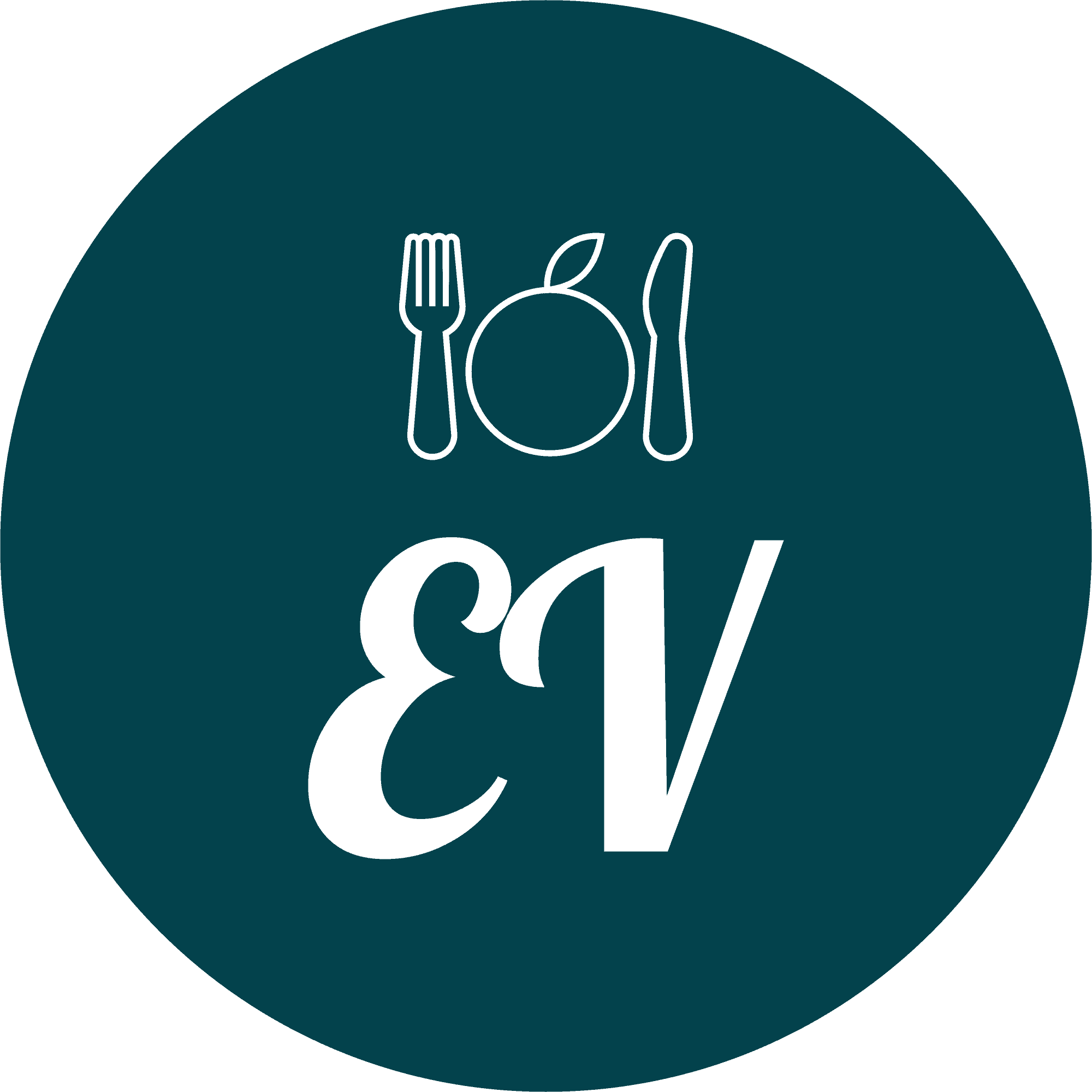Are you among the many individuals who have felt the discomfort of digestive issues after enjoying a bowl of cereal or sipping on your favorite latte?
If so, you’re not alone. The culprit might just be lactose – the natural sugar found in milk.
Don’t worry, there is a solution!
This blog is about exploring the world of lactose free milk and non-dairy substitutes, offering a solution for those seeking a delicious alternative without the unwanted side effects.
In a society that is increasingly mindful of dietary choices and health concerns, the demand for lactose-free options has surged.
From the creaminess of plant-based alternatives and lactose free milk to the nutritional benefits of fortified options, this article will empower you to take action and integrate lactose-free goodness into your daily routine.
Table of Contents
What is Lactose?
Lactose, a natural sugar found in milk and dairy products, is a disaccharide composed of two sugar molecules – glucose and galactose.
Often referred to as milk sugar, lactose is a crucial energy source.
The digestion of lactose is relies upon the enzyme lactase, produced in the small intestine, which breaks down the disaccharide into its constituent sugars for absorption into the bloodstream.
What is Lactose Intolerance?
Lactose intolerance is a prevalent digestive disorder characterized by the body’s inability to fully digest lactose, the sugar found in milk and dairy products.
This condition stems from a deficiency in the enzyme lactase, which is responsible for breaking down lactose into more easily absorbable forms.
Without sufficient lactase, undigested lactose passes into the colon, where it ferments, leading to a range of uncomfortable symptoms such as bloating, gas, abdominal pain, and diarrhoea.
It’s important to note that lactose intolerance is distinct from a milk allergy, as the latter involves the immune system reacting to proteins in milk rather than the inability to digest lactose.
The prevalence of lactose intolerance varies globally, with some populations exhibiting higher rates than others.
It is not difficult to manage lactose intolerance. A few dietary adjustments like opting for lactose-free milk and dairy alternatives can help enjoy the nutritional benefits without the associated digestive distress.
Lactose Free Milk Substitutes and How Do They Benefit?
Lactose-free dairy substitutes have become a cornerstone of dietary choices for individuals seeking to avoid the discomfort associated with lactose intolerance or those opting for a dairy-free lifestyle.
These substitutes offer a diverse array of options, each with its unique flavour profile and nutritional benefits.
They not only cater to lactose-intolerant individuals but also cater to those embracing plant-based diets, providing a wide range of options that align with various taste preferences and dietary needs.
Let’s understand them one-by-one.
Lactose-Free Cow’s Milk
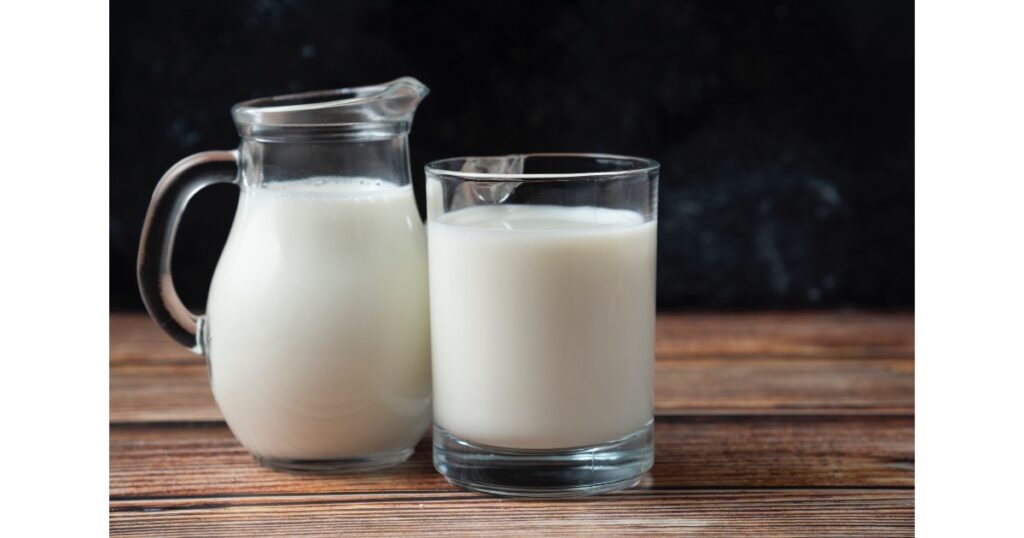
Lactose-free cow’s milk has emerged as a welcome solution for individuals who crave the taste and nutritional benefits of traditional dairy without the discomfort associated with lactose intolerance.
As discussed earlier, we need lactase enzyme to digest lactose in the body. Basis this emerged this new innovation in which regular milk undergoes a process wherein the enzyme lactase is added to break down lactose into more easily digestible sugars, glucose, and galactose1.
The result is a milk that maintains the wholesome goodness of cow’s milk providing calcium, protein, and vitamins while being gentler on the digestive system.
Lactose-free cow’s milk is a versatile choice for cooking, baking, or simply enjoying a refreshing glass.
It is generally available in various fat percentages ensures that individuals can tailor their milk consumption to specific dietary preferences.
This option provides a practical solution for those with lactose intolerance without compromising on taste or nutritional value.
Oat Milk
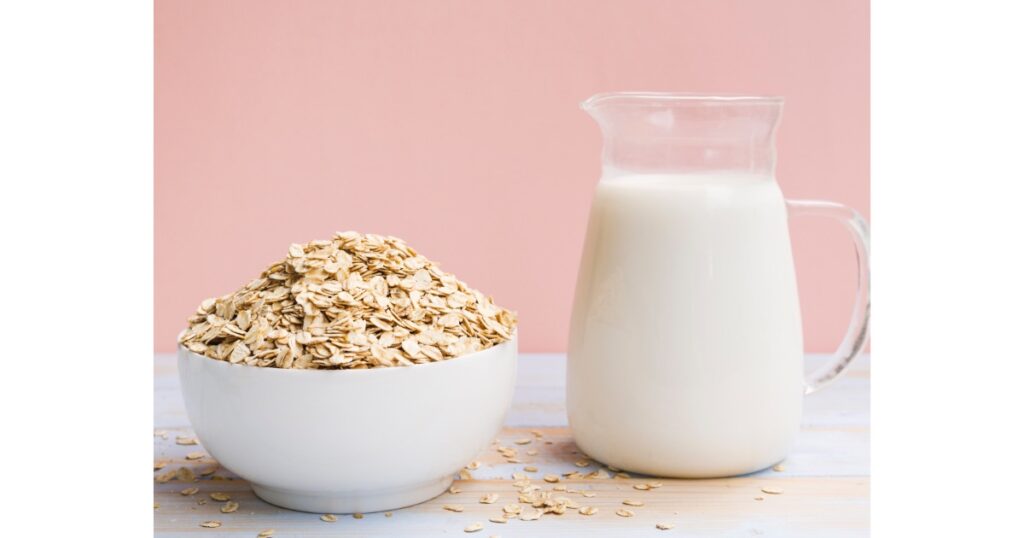
Oat milk has swiftly risen as a popular and versatile lactose free milk alternative, capturing the taste buds of consumers seeking plant-based options.
Crafted from whole oats and water, this milk alternative offers a mild, slightly sweet flavour with a creamy texture, making it a delightful addition to coffee, cereal, and cooking applications.
One of oat milk’s standout features is its impressive nutritional profile, often enriched with vitamins like vitamin D and B12, as well as calcium.
Moreover, it is naturally free of lactose, soy, and nuts, making it an inclusive choice for those with various dietary restrictions or preferences.
It a go-to option for individuals seeking a harmonious blend of flavour and nutrition for vegetarian, vegans and people with lactose allergy or sensitivity.
Soy Milk
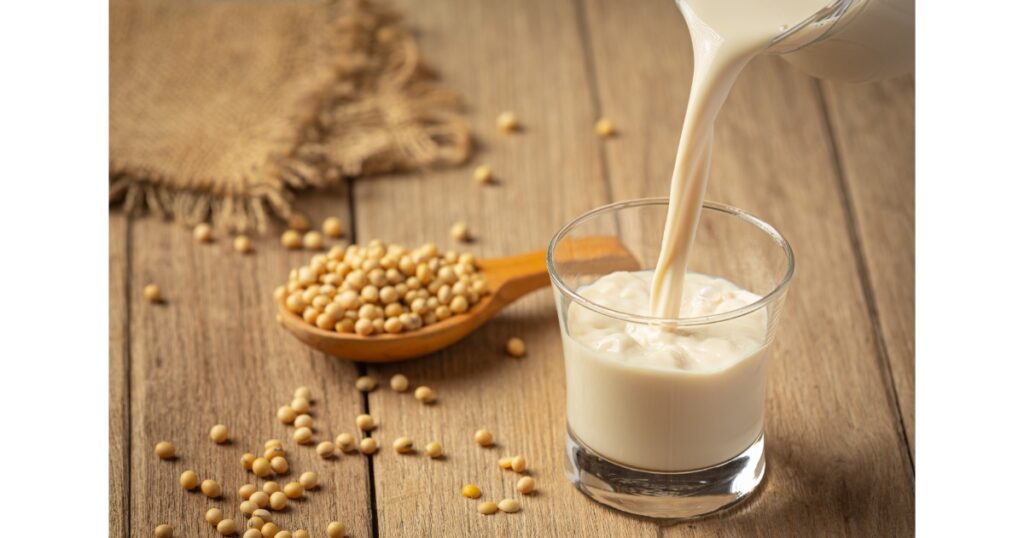
Soy milk, a plant-based alternative, has secured its place as a nutritional powerhouse and versatile dairy-free substitute.
Derived from soybeans, it provides a robust source of protein, making it a particularly appealing option for those seeking a plant-based alternative with comparable nutritional benefits to cow’s milk.
The mild and creamy consistency of soy milk complements various culinary applications, from lattes to smoothies and savory dishes.
Beyond its appealing taste and texture, soy milk is a rich source of essential nutrients, including calcium, vitamin D, and vitamin B12.
Soy milk is naturally lactose and cholesterol-free making it an accessible choice for individuals with dietary restrictions or those exploring a vegan lifestyle.
Almond Milk
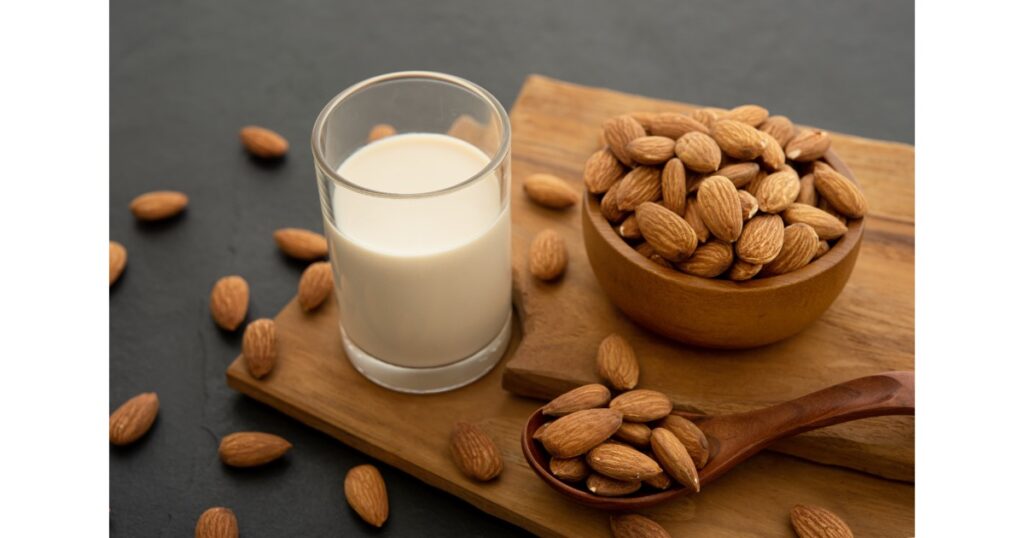
Almond milk is another lactose free milk alternative in the realm of plant-based beverages with its distinct nutty flavour and nutritional benefits.
Made from a blend of finely ground almonds and water, almond milk has a light and slightly sweet taste, making it a versatile addition to both sweet and savoury dishes.
Beyond its pleasing flavour profile, almond milk is naturally lactose-free and low in calories, making it an attractive choice for those seeking a lighter alternative to traditional dairy.
Rich in vitamin E, antioxidants and fortified with calcium and vitamin D, almond milk offers a nutrient-packed option for those with dietary restrictions or those embracing a vegan lifestyle2. Its silky texture makes it a favorite in coffee, cereals, and smoothies.
Cashew Milk
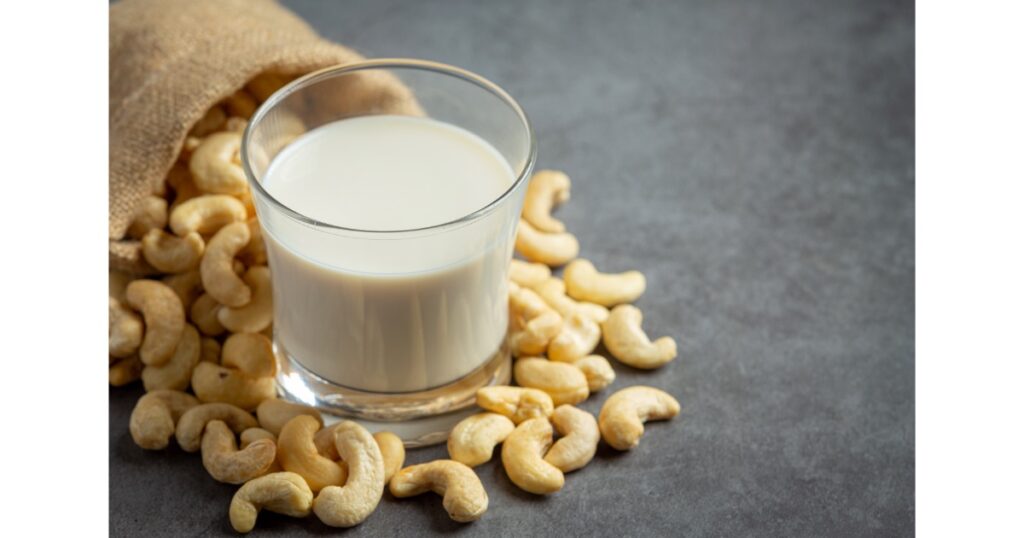
Cashew milk is made by blending cashews with water, this milk offers a velvety texture and a subtle nutty undertone that enhances a variety of culinary creations.
Cashew milk stands out for its versatility, seamlessly integrating into coffee, smoothies, and both sweet and savory dishes. Rich in unsaturated fats, it provides a satisfying mouthfeel without compromising on nutritional value.
Lactose-free and often fortified with essential nutrients like calcium and vitamin D, cashew milk caters to those with dietary restrictions or those seeking a vegan lifestyle.
Cashew milk has emerged not only as a delicious and nutritious choice but also as a sustainable and compassionate alternative in the evolving world of non-dairy beverages.
Rice Milk

Rice milk is derived from milled rice and water, offering a uniquely subtle sweetness.
Characterized by its thin and smooth consistency, rice milk is a versatile option suitable for various culinary applications, from breakfast cereals to baking and cooking.
This naturally lactose free milk is an excellent choice for those with lactose intolerance or other dietary restrictions.
While not as protein-rich as some other plant-based alternatives, rice milk is often fortified with essential nutrients such as calcium, vitamin D, and vitamin B12 to enhance its nutritional profile.
It is hypoallergenic and free of common allergens like soy and nuts, making it an inclusive option for individuals with diverse dietary needs.
Additionally, rice milk’s neutral taste allows it to adapt to both sweet and savory dishes, offering a mild complement to various culinary creations.
As the demand for lactose free milk alternatives continues to rise, rice milk remains a compelling choice, appreciated for its lightness, versatility, and suitability for those with specific dietary considerations.
Coconut Milk
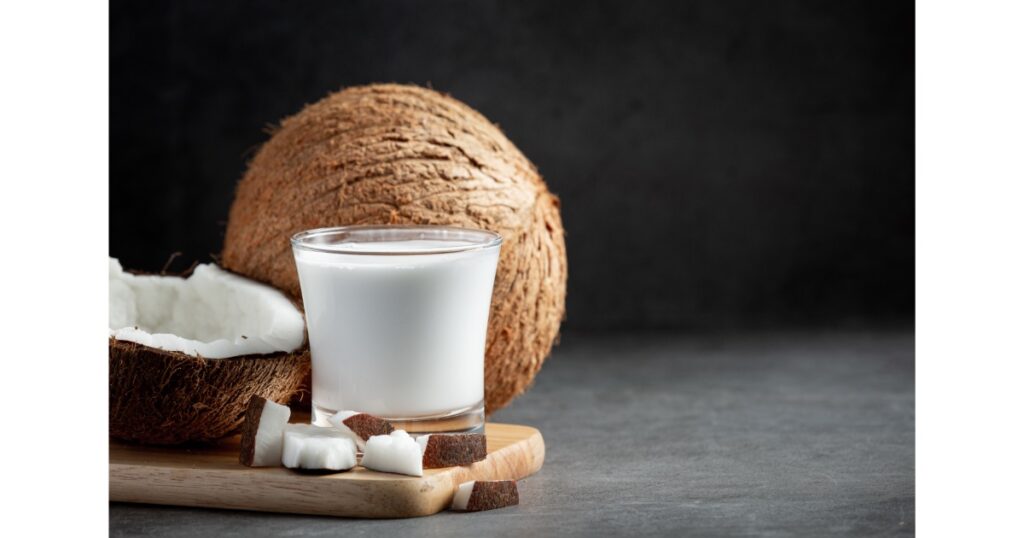
Coconut milk, a luscious and tropical dairy substitute, is derived from the pressing of grated coconut flesh mixed with water.
Known for its rich and creamy texture, coconut milk imparts a distinctively sweet and nutty flavor to both sweet and savoury dishes and is widely used in various culinary traditions around the world.
This non-dairy option is naturally lactose-free and offers a suitable alternative for those with lactose intolerance or seeking plant-based choices.
Beyond its delightful taste, coconut milk is celebrated for its nutritional content, containing healthy fats as medium-chain triglycerides (MCTs) that provide quick bursts of energy3. It is a source of essential minerals like iron, magnesium, and phosphorus.
Coconut milk’s versatility extends from curries and soups to desserts and beverages, and its natural sweetness often reduces the need for added sugars in recipes.
Whether used in cooking or enjoyed as a beverage, coconut milk stands as a decadent yet nutritious choice in the diverse landscape of lactose free milk alternatives.
Here is a combined data of their nutritional values (per 100ml) for you to understand deeper.
| Energy (kcal) | Protein (g) | Carb (g) | Fat (g) | Fibre (g) | Calcium (mg) | |
| Lactose Free Cow’s Milk (Low Fat) | 46 | 3.33 | 5 | 1.04 | 0 | 125 |
| Soy Milk | 38 | 3.55 | 1.29 | 1.88 | <0.45 | 101 |
| Cashew Milk | 10 | 0.42 | 0.83 | 0.83 | 0 | 188 |
| Oat Milk | 48 | 0.8 | 5.1 | 2.75 | <0.75 | 148 |
| Rice Milk | 47 | 0.28 | 9.17 | 0.97 | 0.3 | 118 |
| Coconut Milk | 230 | 2.29 | 5.54 | 23.8 | 2.2 | 16 |
Is Lactose Free Milk Good Compared to Regular Milk?
The choice between lactose-free milk and regular milk depends on individual preferences, dietary needs, and tolerances.
Here are some factors to consider when comparing lactose-free milk to regular milk.
- Lactose Intolerance: Lactose-free milk is an excellent option for individuals who are lactose intolerant. It is treated with the enzyme lactase, which breaks down lactose into simpler sugars, making it easier to digest. Regular milk, on the other hand, contains lactose and may cause digestive discomfort for those with lactose intolerance.
- Nutritional Content: In terms of nutritional content, both lactose-free milk and regular milk can be comparable. Lactose free milk is often fortified with vitamins and minerals, such as calcium and vitamin D, to match the nutritional profile of regular milk. However, the specific nutritional content can vary between brands, so it is advisable to read the labels carefully.
- Taste and Texture: Lactose-free milk generally has a similar taste and texture to regular milk, but individual preferences may vary. Some people find that lactose free milk has a slightly sweeter taste due to the breakdown of lactose into sugars. Experimenting with both options can help determine which one you prefer.
- Availability: Lactose free milk is widely available in various forms, including cow’s milk, almond milk, soy milk, and more. Regular milk also comes in various types, such as whole, skim, and low-fat. The availability of lactose-free options makes it easier for individuals with lactose intolerance to find suitable alternatives.
To sum up, both lactose-free milk and regular milk can be good choices, depending on your dietary needs and preferences.
Lactose Free Milk Side Effects
Lactose free milk is generally considered safe for consumption, especially for individuals who are lactose intolerant.
While lactose free milk is designed to minimize digestive issues for those with lactose intolerance, it’s essential to be aware of potential side effects or considerations.
- Allergies: Some individuals may be allergic to components of lactose-free milk, such as the milk itself or added ingredients. It’s important to read labels carefully, especially if the lactose-free milk contains additional fortifications or flavourings.
- Calorie Load: Lactose-free milk may have a slightly higher caloric content than regular milk, depending on the brand and whether it contains added ingredients like sugars or fats.
- Digestive Sensitivity: While lactose-free milk is designed to be easier on the digestive system, individual responses may vary. Some people may still experience mild digestive discomfort, although this is less common than with regular milk.
The side effects of lactose free milk are typically minimal and vary from person to person. If you have allergy or sensitivity to lactose, it is advisable to consult with a healthcare professional.
Summary
In conclusion, the world of lactose free milk and non-dairy substitutes is not just a realm for those with lactose intolerance; it’s a vast landscape of options catering to diverse dietary preferences.
From almond and soy to coconut, oat, and cashew, each alternative brings its unique flavour, texture, and nutritional profile to the table.
Non-dairy substitutes, in turn, open doors to a plant-based lifestyle, offering a range of alternatives that celebrate variety and sustainability.
Whether you choose lactose-free cow’s milk for its familiar taste, almond milk for its nutty notes, or oat milk for its versatility, the options for you are abundant.
Frequently Asked Questions
Is lactose free milk suitable for someone with lactose intolerance?
Yes, lactose free milk is specifically designed for individuals with lactose intolerance. It undergoes a process where the enzyme lactase is added to break down lactose, making it easier to digest.
Are non-dairy substitutes as nutritious as cow’s milk?
Many non-dairy substitutes are fortified to match the nutritional content of cow’s milk. They can be excellent sources of vitamins, minerals, and proteins, depending on the specific type and brand.
Can lactose-free milk be used in cooking and baking as a substitute for regular milk?
Yes, lactose-free milk can be used as a substitute for regular milk in most recipes without compromising the taste or texture.
Do non-dairy milk alternatives contain calcium and vitamin D?
Many non-dairy milk alternatives are fortified with calcium and vitamin D to provide nutritional benefits similar to cow’s milk.
What is lactose free milk?
Lactose-free milk is a type of milk that has undergone a process to remove or break down lactose, a natural sugar found in milk. To make lactose free milk, the enzyme lactase is added to the milk to break down lactose into its simpler sugar components.
What are the benefits of lactose free milk?
Lactose-free milk retains the essential nutrients found in regular milk, such as calcium, vitamin D, and protein. By breaking down lactose into simpler sugars through the addition of lactase, this milk minimizes digestive discomfort, including bloating, gas, and diarrhoea. It is ideal for people with lactose intolerance.
Is soy milk lactose free?
Absolutely, soy milk is plant-based and does not contain lactose.
Is skim milk the same as lactose free milk?
No, skim milk and lactose-free milk are not the same. Skim milk, also known as fat-free or non-fat milk, refers to milk from which the fat has been removed. It typically contains less than 0.5% milk fat but contains lactose.
Lactose-free milk is not defined by its fat content; it can be whole, reduced-fat, or skim. The primary purpose of lactose-free milk is to provide an option for individuals with lactose intolerance.
How much lactose is present in lactose free milk?
Lactose-free milk is processed to reduce the lactose content, however, the residual lactose content can vary among different brands and products.
In general, most commercially available lactose-free milk contains a minimal amount of lactose, typically around 1% or less of the original lactose content found in regular milk. To determine the specific lactose content in a particular brand or product, it is better to check the nutritional label on the packaging or contact the brand support.
How to make almond milk at home?
One can make almond milk at home by blending soaked almonds with water until a creamy consistency is achieved.
Sources
- Dekker, P., Koenders, D. J. P. C., & Bruins, M. J. (2019). Lactose-Free Dairy Products: market developments, production, nutrition and health benefits. Nutrients, 11(3), 551. https://doi.org/10.3390/nu11030551 ↩︎
- Sobhy, H. M., El, M., Elsabie, W., & FathyForsan, H. (2021). STUDY OF HIGH NUTRITIVE VALUE OF ALMOND MILK BEVERAGE. Plant Archives, 21(supplement 1). https://doi.org/10.51470/plantarchives.2021.v21.s1.405 ↩︎
- Karunasiri, A. N., Gunawardane, M., Senanayake, C., Jayathilaka, N., & Seneviratne, K. (2020). Antioxidant and nutritional properties of domestic and commercial coconut milk preparations. International Journal of Food Science, 2020, 1–9. https://doi.org/10.1155/2020/3489605 ↩︎
